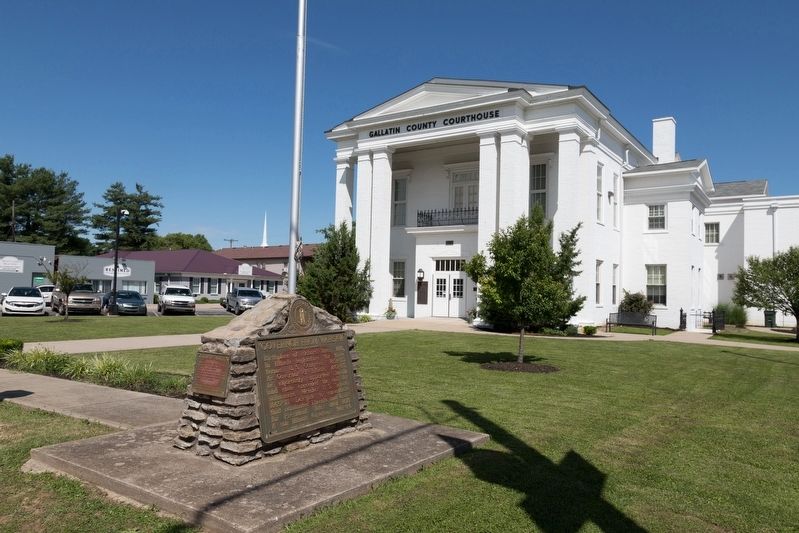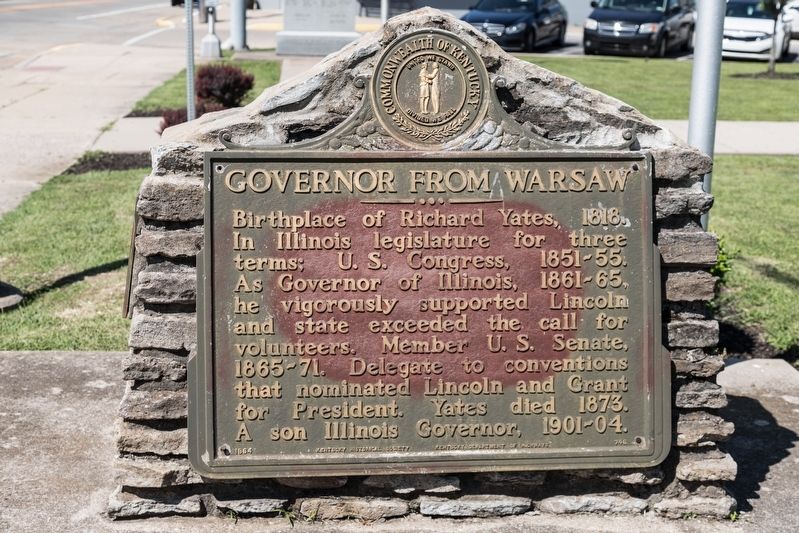Warsaw in Gallatin County, Kentucky — The American South (East South Central)
Governor From Warsaw
Erected 1964 by Kentucky Historical Society and Kentucky Department of Highways. (Marker Number 746.)
Topics and series. This historical marker is listed in this topic list: Government & Politics. In addition, it is included in the Kentucky Historical Society series list. A significant historical year for this entry is 1818.
Location. 38° 47.027′ N, 84° 54.116′ W. Marker is in Warsaw, Kentucky, in Gallatin County. Marker is at the intersection of East Main Street (U.S. 42) and Washington Street, on the right when traveling west on East Main Street. It is at the courthouse. Touch for map. Marker is in this post office area: Warsaw KY 41095, United States of America. Touch for directions.
Other nearby markers. At least 8 other markers are within walking distance of this marker. County Named, 1798 (here, next to this marker); White Store Building (a few steps from this marker); Gallatin County War Memorial (a few steps from this marker); Gallatin County Courthouse (a few steps from this marker); The Gutting House (within shouting distance of this marker); The Saddlery (within shouting distance of this marker); Allen House (within shouting distance of this marker); Henry Yates House (within shouting distance of this marker). Touch for a list and map of all markers in Warsaw.
Also see . . . Wikipedia entry for Richard Yates. “Richard Yates (1815–1873) was the Governor of Illinois during the American Civil War and has been considered one of the most effective war governors. He took energetic measures to secure Cairo and St. Louis against rebel attack. Nicknamed the ‘Soldiers’ Friend,’ he helped organize the Illinois contingent of Union soldiers, including commissioning Ulysses S. Grant as a colonel for an Illinois regiment. He supported the Emancipation Proclamation. He also represented Illinois in the United States House of Representatives (1851–1855) and in the U.S. Senate (1865–1871). As a Senator, he voted and spoke in favor of removing of Andrew Johnson from office.” (Submitted on July 2, 2019.)

Photographed By J. J. Prats, June 12, 2019
2. Governor From Warsaw face of monument
The county courthouse is in the background. The County Named Gallatin marker has been bolted to the other side of the stacked stone and mortar monument.
The small plaque on the side of the monument is titled “Soldier’s Prayer” and placed by the Gallatin Fort No. 145, American Legion, in memory of servicemen of Gallatin County since 1798. It reads,
The small plaque on the side of the monument is titled “Soldier’s Prayer” and placed by the Gallatin Fort No. 145, American Legion, in memory of servicemen of Gallatin County since 1798. It reads,
Oh God of Battle, Lord of Might—
A sentry in the silent night—
I, who’ve never prayed
Kneel on the dew damp sand to say:
Oh, keep me through the coming day!
But, please remember, though I pray,
That I am not afraid.
Credits. This page was last revised on July 2, 2019. It was originally submitted on July 2, 2019, by J. J. Prats of Powell, Ohio. This page has been viewed 158 times since then and 13 times this year. Photos: 1, 2. submitted on July 2, 2019, by J. J. Prats of Powell, Ohio.
